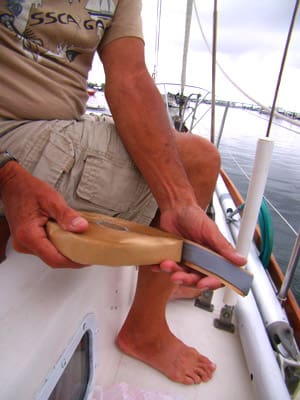Those of us northern sailors who have been out cruising in southern waters for a while know that leaks around ports, chain-plates and other deck fittings can be real pains in the neck (plumbing leaks are a different story). In fact, topside leaks cause us more grief than leaks below the waterline. Of course we only discover topside leaks when it rains or when we hose down the boat. When we leave the boat on the hard for the summer the leaks persist, without us knowing about them, until we discover an unusual amount of fresh water in the bilge and streaks on the interior teak when we return. We have tried everything: 3M Sealer, Boat Caulk, GE Sealer and all (we never use 3M 5200 or 3M 4200 for fear of cementing a leaky port, chain-plate or cleat in-place never to be removed or resealed!). Traditional marine sealers leak much too often especially when exposed to the weather and ultraviolet (UV) rays for long periods of time.
|
|
|
|
One of our sailing friends asked, “Why can’t we use the same stuff they use to seal automobile windshields?” Automobiles use butyl rubber tape sealer or butyl rubber gaskets. The stuff lasts forever (visit a automobile junkyard and try to find a leaky windshield).
A Google search eventually turned up butyl rubber in several forms. What I was looking for was one-inch-wide, double-stick tape, perhaps 1/8 thick. You can buy butyl rubber in a tube from an auto store, but it comes only in black and is nearly as messy as regular marine caulking. I wanted tape that would stay in place as we put the pieces together and not run all over the place. I discovered a company in Arizona named Best Materials (www.bestmaterials.com). They sell all kinds of butyl rubber products mostly used as gaskets and sealant for roofs. A gray, 50-foot roll of one-inch-wide, 3/32-inch-thick, double-stick tape costs $5.75. The shipping costs more than two rolls! We decided to try it.
We replaced one of our four cabin ports with new smoke-tint quarter-inch Lexan. (We took the old, badly crazed, acrylic port to a custom glass place and told them to copy it in Lexan). After reasonably good luck, and no mess, installing the new port using the butyl tape, we sprayed it with a garden hose; the result: no leaks! We immediately decided to do the other three ports.
We cut the tape lengthwise to be a half-inch wide, and used it to seal the inside and outside aluminum trim and filled the barrel-bolt holes with conventional GE Clear Sealer just in case. So far so good. Best of all the butyl tape is easy to apply, comes in a roll, stores ready to use (won’t dry-up in the tube like all the other products we’ve tried), no leaky caulking that sticks to everything, including the crew, and no mess to clean off the ports and interior teak. It seems to last and never lose its flexibility.
After we tightened the trim barrel-bolts, we trimmed off any overflow of butyl tape with a plastic credit card so as not to scratch the Lexan. We’re so confident we even did our leaky chain-plates and saved lots of tape for other deck hardware.
Once in a while we find something new that works. We now carry a big roll of the stuff. We plan to use it for all our weather deck fittings and anything else we can think of. We’re even thinking of butyl rubber gaskets around the head in place of the leaky “O” ring on top of the Y valve, for example.
————-
Dick de Grasse and his wife Kathy live aboard their Tartan 34, Endeavour, in Florida during the winter and in Islesboro, Maine, during the summer.

